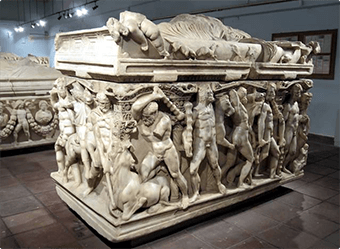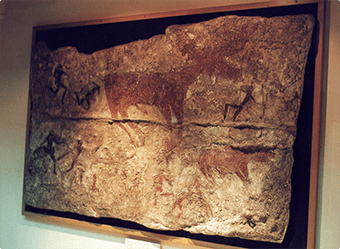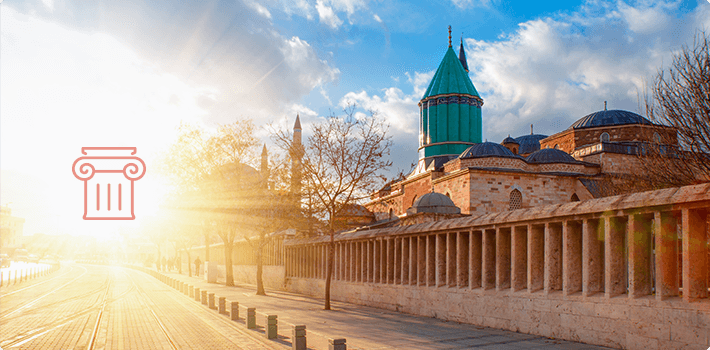Konya is one of our rare cities of which names have not been changed for ages. It is rumored that its name is derived from the word 'Icon' which means 'Sacred Image'. Another story about its name tells that a monument was built in memory for the person who killed the dragon bothering the city, and this monument's name was also 'Iconion'. There are other such rumors about the name story of Konya.
People in Konya had already adopted a sedentary life for 7000 BC. It is one of the oldest cities of our country. It was in territories of several states and became a capital as well.


Konya was in the territory of Byzantine Empire until the 10th Century. The Seljuk Turks came to Konya after the 10th Century. The Seljuk Empire defeated the Byzantine Empire and the Turks entered into Anatolia having conquered Konya. Following the conquest, the period of Turkish-Islamic domination began in Konya. These events resulted in Turkification and Islamification of Anatolia. The freedom of thought and faith increased the loyalty of the local people to the state.
Konya blossom out and enjoyed its sort of golden age with the architectural works of art of the Anatolian Seljuk Sultanate. Poets, philosophers and scholars of the era spent time in Konya. Sufis such as Baha al-Din Walad, Mawlana Jalaluddin Rumi and Shams Tabrizi in our city and produced their most well-known works in Konya. Konya, which was ruled by the Anatolian Seljuk Sultanate for 211 years, became one of the most developed cities of Anatolia during that era.
In 1308, after the collapse of the Anatolian Seljuk Sultanate, Konya was ruled by the Karamanid Principality. In 1465, Mehmed the Conqueror, the Sultan of the Ottoman Empire, ended the Principality of Karaman, and Konya became a neighbor of the Ottoman Empire. The capitol of the province of Karaman that was founded as a province became Konya. Later, this name changed to Konya Province. Today, Konya, which grew and thrived quickly, is among the most developed cities of our country.

Tourism in Konya
Each country, region and city has their own structures reflecting values peculiar to these places. These structures also have their own unique stories. This is where exactly the concept of tourism emerges. People go on tourist trips towards different cities of different countries for they are curious about and want to learn about the values and phenomena in different countries.
The period from the first Sunday of December to the 17th day of December is celebrated as Mawlana Week in Konya, which has become an important tourism center. When looking at these celebrations, we can understand that Konya is a city caring about its spiritual values.
Not only Mawlana Week is celebrated in Konya. Various festivals and competitions are organized in several weeks throughout the year. Akşehir Nasreddin Hodja Festivals on July 5-11, Festival of Minstrels on October 25-30, Javelin Throwing Competitions on September 9 and Konya Fair from 5 August to 5 September are among tourism events of Konya.
It ranks at the 4th place among other cities in terms of the richness of architectural constructions. Konya, which has a rich treasure in terms of historical and artistic works, is literally a monument of civilization rising in the middle of the Savannah. The historical artifacts can be listed as follows;
Alaeddin Mosque : It is the largest and the most important mosque of the Anatolian Seljuk Sultanate era. Built at the top of Alaeddin Hill, the mosque is among the most beautiful examples of the Seljuk architecture.
Mawlana Tomb and Mawlawi Dervish Lodge Complex : Mawlana Jalaluddin Rumi is a figure associated with the city of Konya. Mawlana is the first name that comes to mind when it comes to Konya and vice versa. The number of visitors visiting the Mevlana Museum every year proves this. Mawlana Jalaluddin Rumi, an Islamic scholar and thinker, is entombed in the tomb.
Kılıçarslan Mansion : The mansion, which was built by Sultan Kılıçaslan II, in the city center, surrounds the tumulus called Alaeddin Hill. Only the eastern wall of the mansion survived to the present day. The mansion is now under restoration for commissioning as a touristic facility.
Karatay Madrasa : This madrasa was built in 1251 by Emir Celaleddin Karatay during İzzeddin Keykavus era. However, it was abandoned in the 19th century. Today, it is used as 'Glazed Tile Works Museum'.
Nasreddin Hodja's Tomb : The humorist Nasreddin Hodja's Tomb is located in Akşehir, the city where he lived. The structure which lost its original shape was given its present appearance by Şükrü Bey, district-governor of Akşehir.
Selimiye Mosque : The construction of the mosque started during the Reign of Sultan Selim II. It is among the works that reflect the Ottoman architecture most beautifully. Historians argue that the structure was built by Sinan the Architect.
Eshrefid Mosque : The mosque is located 100 meters north of Lake Beyşehir. It was built by Eshrefid Emir Suleiman Beg in 1299. It is one of the works that reflect the Seljuk tradition.
İnce Minaret Madrasa : It is located west of Alaeddin Hill. It was built by the Vizier Sahip Ata Fahreddin Ali during the reign of Sultan Izzeddin Keykavus II for the purpose of teaching science. The architect was Kelik Bin Abdullah. The crown door of the madrasa contains the Surah Yasin and Surat al-Fatihah. The madrasa is comprised of a courtyard, iwan, classrooms and student cells. It has been used as a museum since 1956.